We have already admired the beauty of American irises, this week another iris, a Chinese one, will catch our attention, especially since it is quite rare.
Like all Iridaceae, it presents a tuft of sheathing leaves, erect, long and narrow, which start from a creeping rhizome. The flowers are grouped at the end of the stem; they look like a star, but if you look closely the 6 tepals (both sepals and petals) are of different sizes: the petals are a little longer and wider than the sepals; but all 6 are orange-yellow, marked with dark red dots and lines. The fruits are three-valved turbinate capsules filled with small, black, shiny seeds.
In Western languages the characters of this plant induce its names; in French we speak of “leopard flower” because the spots on the sepals are reminiscent of those on the animal’s skin; in English the small round and black seeds, which remain for a certain time on the plant, are seen as blackberries, hence the name Blackberry Lily. In Thai it is once again the tuberous root, van, which is used to name this plant. In Lao we have two names which both refer to the foliage, houang khao, “ear of rice”, because the leaves can resemble those of rice (?) and also gna kap or dok kap, “kap” meaning “sheathing leaf »; Note that this name also applies to a decorative pandanus which has the same type of leaf. One of the scientific names, Belamcanda, was given in 1763, after numerous changes, by Adanson, a famous naturalist of the Age of Enlightenment; he was inspired by a language from eastern India where this flower may have originated.
In China this Iris (formerly called Belamcanda chinensis) is an important medicinal plant; its rhizome called shè gàn is considered bitter and cold, “it cleanses the blood and eliminates toxins, it dissipates phlegm”; it is also used to fight against wet coughs; it is taken in decoction, powder, granules.
In Laos gna kap has anti-inflammatory properties; we macerate the rhizome in water or alcohol and gargle with this liquid in case of sore throat or fever; the crushed rhizome is also applied to snake bites. In Thailand, a decoction of the leaves is reputed to be laxative and is said to treat menstrual disorders; the rhizome, in addition to the uses listed in Laos, is called tonic.
Nous avons déjà admiré la beauté des iris américains, cette semaine un autre iris, chinois celui-là, retiendra notre attention, d’autant plus qu’il est assez rare.
Comme toutes les Iridacées il présente une touffe de feuilles engainantes, dressées, longues et étroites, qui partent d’un rhizome rampant. Les fleurs sont groupées en bout de tige; elles ressemblent à une étoile, mais à y bien regarder les 6 tépales (à la fois sépales et pétales) sont de taille différente: les pétales sont un peu plus longs et plus larges que les sépales; mais tous les 6 sont jaune orangé, marqués de points et de lignes rouge foncé. Les fruits sont des capsules turbinées à trois valves remplies de petites graines noires et brillantes.
Dans les langues occidentales les caractères de cette plante induisent ses noms; en français on parle de « fleur léopard » car les taches des sépales font penser à celles de la peau de l’animal; en anglais les petites graines rondes et noires, qui restent un certain temps sur la plante sont vues comme des mûres, d’où le nom blackberry lily. En thaï c’est une fois encore la racine tubéreuse, van, qui sert à nommer ce végétal. En lao on a deux noms qui tous deux font référence au feuillage, houang khao, « épi de riz », car les feuilles peuvent ressembler à celles du riz ( ?) et aussi gna kap ou dok kap, « kap » signifiant « feuille engainante »; signalons que ce nom s’applique aussi à un pandanus décoratif qui a le même type de feuille. L’un des noms scientifiques, Belamcanda, a été donné en 1763, après de nombreux changements, par Adanson, célèbre naturaliste du siècle des Lumières; il s’est inspiré d’une langue de l’est de l’Inde d’où est peut-être originaire cette fleur.
En Chine cet Iris (autrefois nommé Belamcanda chinensis) est une plante médicinale importante; son rhizome nommé shè gàn est considéré comme amer et froid, « il nettoie le sang et élimine les toxines, il dissipe les phlegme »; il est aussi employé pour lutter contre la toux grasse; il est pris en décoction, poudre, granulés.
Au Laos gna kap a des propriétés anti-inflammatoires; on fait macérer le rhizome dans de l’eau ou de l’alcool et on se gargarisme avec ce liquide en cas de maux de gorge ou de fièvre; le rhizome écrasé est également appliqué sur les morsures de serpent. En Thaïlande la décoction des feuilles est réputée laxative et traiterait les désordres menstruels; le rhizome, en plus des usages répertoriés au Laos, est dit tonique.
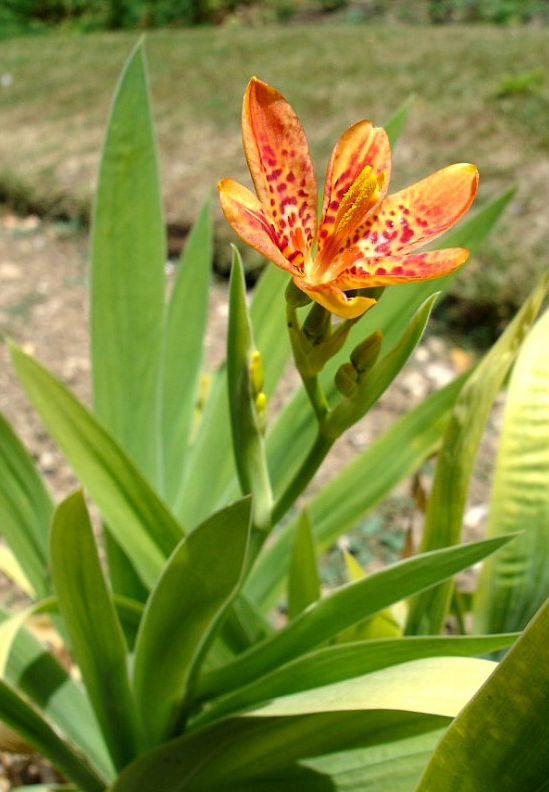
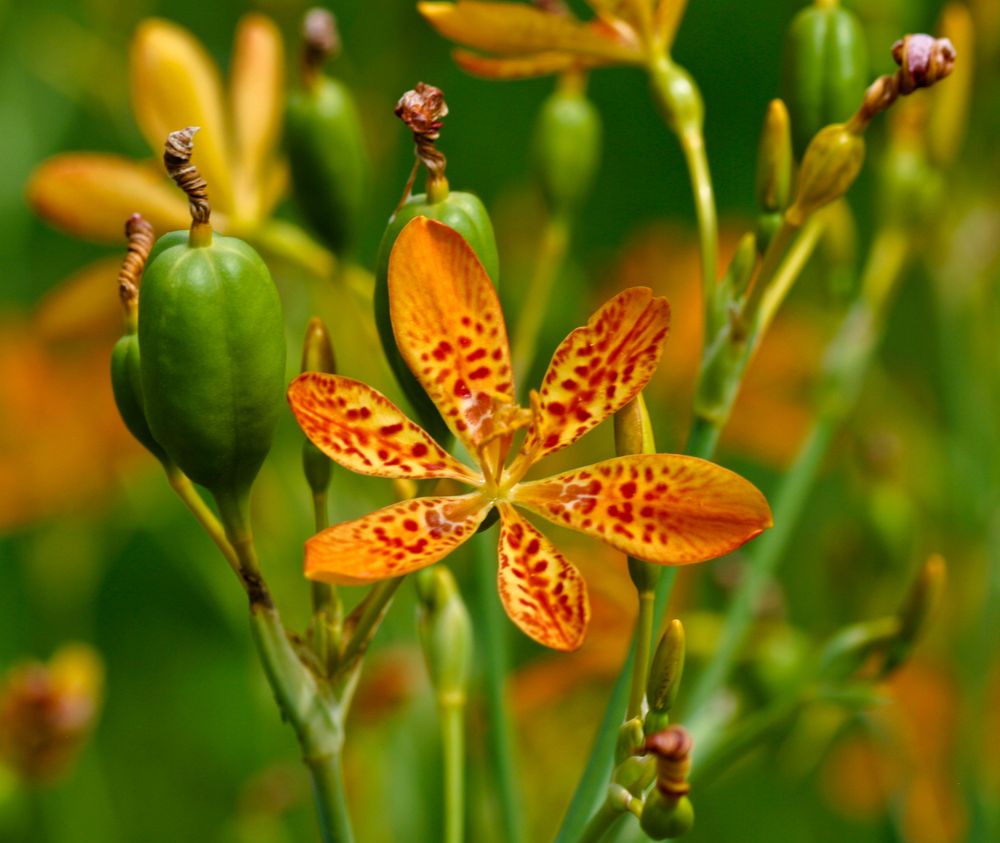
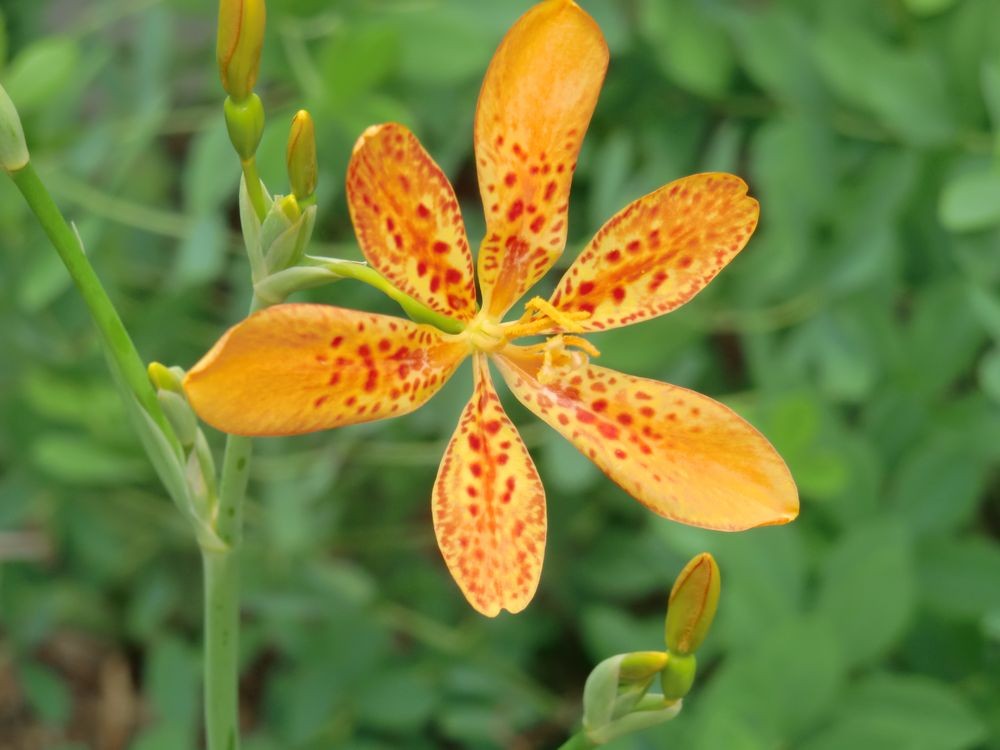
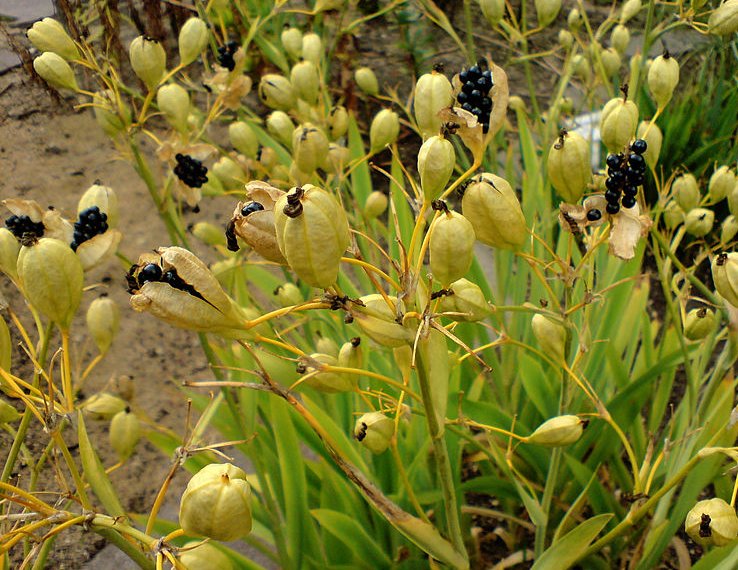
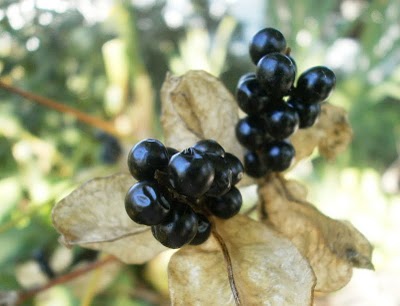
We have already admired the beauty of American irises, this week another iris, a Chinese one, will catch our attention, especially since it is quite rare.
Like all Iridaceae, it presents a tuft of sheathing leaves, erect, long and narrow, which start from a creeping rhizome. The flowers are grouped at the end of the stem; they look like a star, but if you look closely the 6 tepals (both sepals and petals) are of different sizes: the petals are a little longer and wider than the sepals; but all 6 are orange-yellow, marked with dark red dots and lines. The fruits are three-valved turbinate capsules filled with small, black, shiny seeds.
In Western languages the characters of this plant induce its names; in French we speak of “leopard flower” because the spots on the sepals are reminiscent of those on the animal’s skin; in English the small round and black seeds, which remain for a certain time on the plant, are seen as blackberries, hence the name Blackberry Lily. In Thai it is once again the tuberous root, van, which is used to name this plant. In Lao we have two names which both refer to the foliage, houang khao, “ear of rice”, because the leaves can resemble those of rice (?) and also gna kap or dok kap, “kap” meaning “sheathing leaf »; Note that this name also applies to a decorative pandanus which has the same type of leaf. One of the scientific names, Belamcanda, was given in 1763, after numerous changes, by Adanson, a famous naturalist of the Age of Enlightenment; he was inspired by a language from eastern India where this flower may have originated.
In China this Iris (formerly called Belamcanda chinensis) is an important medicinal plant; its rhizome called shè gàn is considered bitter and cold, “it cleanses the blood and eliminates toxins, it dissipates phlegm”; it is also used to fight against wet coughs; it is taken in decoction, powder, granules.
In Laos gna kap has anti-inflammatory properties; we macerate the rhizome in water or alcohol and gargle with this liquid in case of sore throat or fever; the crushed rhizome is also applied to snake bites. In Thailand, a decoction of the leaves is reputed to be laxative and is said to treat menstrual disorders; the rhizome, in addition to the uses listed in Laos, is called tonic.
Nous avons déjà admiré la beauté des iris américains, cette semaine un autre iris, chinois celui-là, retiendra notre attention, d’autant plus qu’il est assez rare.
Comme toutes les Iridacées il présente une touffe de feuilles engainantes, dressées, longues et étroites, qui partent d’un rhizome rampant. Les fleurs sont groupées en bout de tige; elles ressemblent à une étoile, mais à y bien regarder les 6 tépales (à la fois sépales et pétales) sont de taille différente: les pétales sont un peu plus longs et plus larges que les sépales; mais tous les 6 sont jaune orangé, marqués de points et de lignes rouge foncé. Les fruits sont des capsules turbinées à trois valves remplies de petites graines noires et brillantes.
Dans les langues occidentales les caractères de cette plante induisent ses noms; en français on parle de « fleur léopard » car les taches des sépales font penser à celles de la peau de l’animal; en anglais les petites graines rondes et noires, qui restent un certain temps sur la plante sont vues comme des mûres, d’où le nom blackberry lily. En thaï c’est une fois encore la racine tubéreuse, van, qui sert à nommer ce végétal. En lao on a deux noms qui tous deux font référence au feuillage, houang khao, « épi de riz », car les feuilles peuvent ressembler à celles du riz ( ?) et aussi gna kap ou dok kap, « kap » signifiant « feuille engainante »; signalons que ce nom s’applique aussi à un pandanus décoratif qui a le même type de feuille. L’un des noms scientifiques, Belamcanda, a été donné en 1763, après de nombreux changements, par Adanson, célèbre naturaliste du siècle des Lumières; il s’est inspiré d’une langue de l’est de l’Inde d’où est peut-être originaire cette fleur.
En Chine cet Iris (autrefois nommé Belamcanda chinensis) est une plante médicinale importante; son rhizome nommé shè gàn est considéré comme amer et froid, « il nettoie le sang et élimine les toxines, il dissipe les phlegme »; il est aussi employé pour lutter contre la toux grasse; il est pris en décoction, poudre, granulés.
Au Laos gna kap a des propriétés anti-inflammatoires; on fait macérer le rhizome dans de l’eau ou de l’alcool et on se gargarisme avec ce liquide en cas de maux de gorge ou de fièvre; le rhizome écrasé est également appliqué sur les morsures de serpent. En Thaïlande la décoction des feuilles est réputée laxative et traiterait les désordres menstruels; le rhizome, en plus des usages répertoriés au Laos, est dit tonique.










We have already admired the beauty of American irises, this week another iris, a Chinese one, will catch our attention, especially since it is quite rare.
Like all Iridaceae, it presents a tuft of sheathing leaves, erect, long and narrow, which start from a creeping rhizome. The flowers are grouped at the end of the stem; they look like a star, but if you look closely the 6 tepals (both sepals and petals) are of different sizes: the petals are a little longer and wider than the sepals; but all 6 are orange-yellow, marked with dark red dots and lines. The fruits are three-valved turbinate capsules filled with small, black, shiny seeds.
In Western languages the characters of this plant induce its names; in French we speak of “leopard flower” because the spots on the sepals are reminiscent of those on the animal’s skin; in English the small round and black seeds, which remain for a certain time on the plant, are seen as blackberries, hence the name Blackberry Lily. In Thai it is once again the tuberous root, van, which is used to name this plant. In Lao we have two names which both refer to the foliage, houang khao, “ear of rice”, because the leaves can resemble those of rice (?) and also gna kap or dok kap, “kap” meaning “sheathing leaf »; Note that this name also applies to a decorative pandanus which has the same type of leaf. One of the scientific names, Belamcanda, was given in 1763, after numerous changes, by Adanson, a famous naturalist of the Age of Enlightenment; he was inspired by a language from eastern India where this flower may have originated.
In China this Iris (formerly called Belamcanda chinensis) is an important medicinal plant; its rhizome called shè gàn is considered bitter and cold, “it cleanses the blood and eliminates toxins, it dissipates phlegm”; it is also used to fight against wet coughs; it is taken in decoction, powder, granules.
In Laos gna kap has anti-inflammatory properties; we macerate the rhizome in water or alcohol and gargle with this liquid in case of sore throat or fever; the crushed rhizome is also applied to snake bites. In Thailand, a decoction of the leaves is reputed to be laxative and is said to treat menstrual disorders; the rhizome, in addition to the uses listed in Laos, is called tonic.
Nous avons déjà admiré la beauté des iris américains, cette semaine un autre iris, chinois celui-là, retiendra notre attention, d’autant plus qu’il est assez rare.
Comme toutes les Iridacées il présente une touffe de feuilles engainantes, dressées, longues et étroites, qui partent d’un rhizome rampant. Les fleurs sont groupées en bout de tige; elles ressemblent à une étoile, mais à y bien regarder les 6 tépales (à la fois sépales et pétales) sont de taille différente: les pétales sont un peu plus longs et plus larges que les sépales; mais tous les 6 sont jaune orangé, marqués de points et de lignes rouge foncé. Les fruits sont des capsules turbinées à trois valves remplies de petites graines noires et brillantes.
Dans les langues occidentales les caractères de cette plante induisent ses noms; en français on parle de « fleur léopard » car les taches des sépales font penser à celles de la peau de l’animal; en anglais les petites graines rondes et noires, qui restent un certain temps sur la plante sont vues comme des mûres, d’où le nom blackberry lily. En thaï c’est une fois encore la racine tubéreuse, van, qui sert à nommer ce végétal. En lao on a deux noms qui tous deux font référence au feuillage, houang khao, « épi de riz », car les feuilles peuvent ressembler à celles du riz ( ?) et aussi gna kap ou dok kap, « kap » signifiant « feuille engainante »; signalons que ce nom s’applique aussi à un pandanus décoratif qui a le même type de feuille. L’un des noms scientifiques, Belamcanda, a été donné en 1763, après de nombreux changements, par Adanson, célèbre naturaliste du siècle des Lumières; il s’est inspiré d’une langue de l’est de l’Inde d’où est peut-être originaire cette fleur.
En Chine cet Iris (autrefois nommé Belamcanda chinensis) est une plante médicinale importante; son rhizome nommé shè gàn est considéré comme amer et froid, « il nettoie le sang et élimine les toxines, il dissipe les phlegme »; il est aussi employé pour lutter contre la toux grasse; il est pris en décoction, poudre, granulés.
Au Laos gna kap a des propriétés anti-inflammatoires; on fait macérer le rhizome dans de l’eau ou de l’alcool et on se gargarisme avec ce liquide en cas de maux de gorge ou de fièvre; le rhizome écrasé est également appliqué sur les morsures de serpent. En Thaïlande la décoction des feuilles est réputée laxative et traiterait les désordres menstruels; le rhizome, en plus des usages répertoriés au Laos, est dit tonique.


